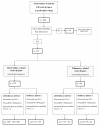Combination of lung ultrasound (a comet-tail sign) and N-terminal pro-brain natriuretic peptide in differentiating acute heart failure from chronic obstructive pulmonary disease and asthma as cause of acute dyspnea in prehospital emergency setting
- PMID: 21492424
- PMCID: PMC3219397
- DOI: 10.1186/cc10140
Combination of lung ultrasound (a comet-tail sign) and N-terminal pro-brain natriuretic peptide in differentiating acute heart failure from chronic obstructive pulmonary disease and asthma as cause of acute dyspnea in prehospital emergency setting
Erratum in
- Crit Care. 2011;15(6):450
Abstract
Introduction: We studied the diagnostic accuracy of bedside lung ultrasound (the presence of a comet-tail sign), N-terminal pro-brain natriuretic peptide (NT-proBNP) and clinical assessment (according to the modified Boston criteria) in differentiating heart failure (HF)-related acute dyspnea from pulmonary (chronic obstructive pulmonary disease (COPD)/asthma)-related acute dyspnea in the prehospital setting.
Methods: Our prospective study was performed at the Center for Emergency Medicine, Maribor, Slovenia, between July 2007 and April 2010. Two groups of patients were compared: a HF-related acute dyspnea group (n = 129) and a pulmonary (asthma/COPD)-related acute dyspnea group (n = 89). All patients underwent lung ultrasound examinations, along with basic laboratory testing, rapid NT-proBNP testing and chest X-rays.
Results: The ultrasound comet-tail sign has 100% sensitivity, 95% specificity, 100% negative predictive value (NPV) and 96% positive predictive value (PPV) for the diagnosis of HF. NT-proBNP (cutoff point 1,000 pg/mL) has 92% sensitivity, 89% specificity, 86% NPV and 90% PPV. The Boston modified criteria have 85% sensitivity, 86% specificity, 80% NPV and 90% PPV. In comparing the three methods, we found significant differences between ultrasound sign and (1) NT-proBNP (P < 0.05) and (2) Boston modified criteria (P < 0.05). The combination of ultrasound sign and NT-proBNP has 100% sensitivity, 100% specificity, 100% NPV and 100% PPV. With the use of ultrasound, we can exclude HF in patients with pulmonary-related dyspnea who have positive NT-proBNP (> 1,000 pg/mL) and a history of HF.
Conclusions: An ultrasound comet-tail sign alone or in combination with NT-proBNP has high diagnostic accuracy in differentiating acute HF-related from COPD/asthma-related causes of acute dyspnea in the prehospital emergency setting.
Trial registration: ClinicalTrials.gov NCT01235182.
Figures
Comment in
-
Using lung ultrasound to differentiate patients in acute dyspnea in the prehospital emergency setting.Crit Care. 2011;15(3):161. doi: 10.1186/cc10226. Epub 2011 May 26. Crit Care. 2011. PMID: 21635703 Free PMC article.
Similar articles
-
Combination of quantitative capnometry, N-terminal pro-brain natriuretic peptide, and clinical assessment in differentiating acute heart failure from pulmonary disease as cause of acute dyspnea in pre-hospital emergency setting: study of diagnostic accuracy.Croat Med J. 2009 Apr;50(2):133-42. doi: 10.3325/cmj.2009.50.133. Croat Med J. 2009. PMID: 19399946 Free PMC article.
-
Using Lung Ultrasound Combined With N-terminal Pro-brain Natriuretic Peptide to Differentiate Acute Heart Failure From Chronic Obstructive Pulmonary Disease and Asthma in Emergency Department Patients Experiencing Acute Shortness of Breath.Cureus. 2025 Jan 9;17(1):e77171. doi: 10.7759/cureus.77171. eCollection 2025 Jan. Cureus. 2025. PMID: 39925500 Free PMC article.
-
Amino-terminal pro-brain natriuretic peptide for the diagnosis of acute heart failure in patients with previous obstructive airway disease.Ann Emerg Med. 2006 Jul;48(1):66-74. doi: 10.1016/j.annemergmed.2005.12.022. Epub 2006 Feb 17. Ann Emerg Med. 2006. PMID: 16781921
-
Amino-terminal pro-B-type natriuretic peptide testing for the diagnosis or exclusion of heart failure in patients with acute symptoms.Am J Cardiol. 2008 Feb 4;101(3A):29-38. doi: 10.1016/j.amjcard.2007.11.017. Am J Cardiol. 2008. PMID: 18243855 Review.
-
Role of pulmonary ultrasonography in diagnosis of acute heart failure.Curr Probl Cardiol. 2025 Jan;50(1):102910. doi: 10.1016/j.cpcardiol.2024.102910. Epub 2024 Oct 28. Curr Probl Cardiol. 2025. PMID: 39477175 Review.
Cited by
-
Diagnostic accuracy of physician-staffed emergency medical teams: a retrospective observational cohort study of prehospital versus hospital diagnosis in a 10-year interval.Scand J Trauma Resusc Emerg Med. 2019 Apr 2;27(1):36. doi: 10.1186/s13049-019-0617-3. Scand J Trauma Resusc Emerg Med. 2019. PMID: 30940205 Free PMC article.
-
Lung Ultrasound to Assess Pulmonary Congestion in Patients with Acute Exacerbation of COPD.Int J Chron Obstruct Pulmon Dis. 2023 Apr 25;18:693-703. doi: 10.2147/COPD.S396855. eCollection 2023. Int J Chron Obstruct Pulmon Dis. 2023. PMID: 37128214 Free PMC article.
-
Use of BNP and NT-proBNP for the diagnosis of heart failure in the emergency department: a systematic review of the evidence.Heart Fail Rev. 2014 Aug;19(4):421-38. doi: 10.1007/s10741-014-9447-6. Heart Fail Rev. 2014. PMID: 24957908
-
A Simplified Ultrasound Comet Tail Grading Scoring to Assess Pulmonary Congestion in Patients with Heart Failure.Biomed Res Int. 2018 Jan 2;2018:8474839. doi: 10.1155/2018/8474839. eCollection 2018. Biomed Res Int. 2018. PMID: 29487872 Free PMC article.
-
How and When to Use Lung Ultrasound in Patients with Heart Failure?Rev Cardiovasc Med. 2022 May 30;23(6):198. doi: 10.31083/j.rcm2306198. eCollection 2022 Jun. Rev Cardiovasc Med. 2022. PMID: 39077188 Free PMC article. Review.
References
-
- Klemen P, Golub M, Grmec S. Combination of quantitative capnometry, N-terminal pro-brain natriuretic peptide, and clinical assessment in differentiating acute heart filure from pulmonary disease as cause of acute dyspnea in prehospital emergency setting: study of diagnostic accuracy. Croat Med J. 2009;50:133–142. doi: 10.3325/cmj.2009.50.133. - DOI - PMC - PubMed
-
- Michota FA Jr, Amin A. Bridging the gap between evidence and practice in acute decompensated heart failure management. J Hosp Med. 2008;3(6 Suppl):S7–S15. - PubMed
Publication types
MeSH terms
Substances
Associated data
LinkOut - more resources
Full Text Sources
Medical
Research Materials
Miscellaneous


